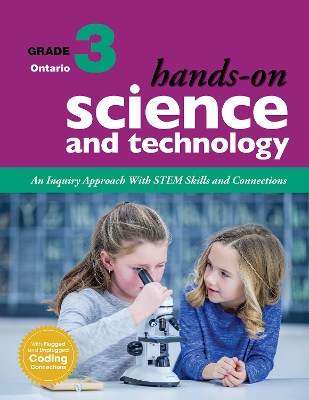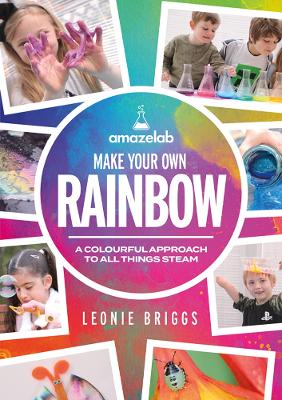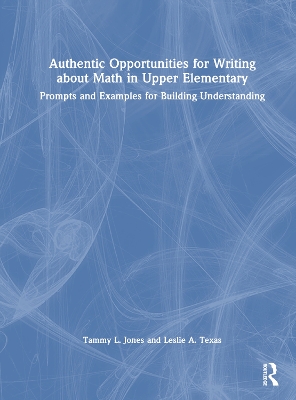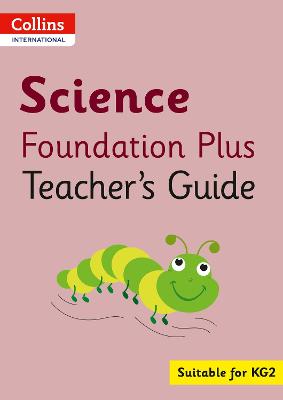Hands-On Science and Technology for Ontario, Grade 3
 portes grátis
portes grátis
Hands-On Science and Technology for Ontario, Grade 3
An Inquiry Approach With STEM Skills and Connections
Manitowabi, Jennifer; Lawson, Jennifer E.; Ierullo, Kellie
Portage & Main Press
10/2024
360
Spiral bound
Inglês
9781774920688
15 a 20 dias
Descrição não disponível.
Introduction to Hands-On Science and Technology for Ontario, Grade 3 1
Introduction to Hands-On Science and Technology 2
Program Introduction 2
The Inquiry Approach to Science and Technology 2
21st Century Teaching and Learning 3
The Goals of the Science and Technology Program 3
Hands-On Science and Technology Strands and Expectations 4
Hands-On Science and Technology Fundamental Concepts and Big Ideas 4
Hands-On Science and Technology Program Principles 5
Infusing Indigenous Perspectives 5
Cultural Connections 7
Land-Based Learning 7
Technology 7
Sustainability 7
Program Implementation 8
Program Resources 8
Classroom Environment 11
Planning Units-Timelines 12
Classroom Management 12
Classroom Safety 12
Scientific Inquiry Skills: Guidelines for Teachers 12
Observing 12
Questioning 13
Exploring 13
Classifying 13
Measuring 14
Communicating, Analyzing, and Interpreting 14
Predicting 15
Inferring 15
Inquiry Through Investigating and Experimenting 16
Inquiry Through Research 16
Online Considerations 17
Addressing Students' Early Literacy Needs 17
Technological Problem Solving 17
Makerspace 18
The Hands-On Science and Technology Assessment Plan 20
Assessment for Learning 21
Assessment as Learning 21
Assessment of Learning 22
Performance Assessment 23
Portfolios 23
Evidence of Student Achievement Levels for Evaluation 24
Important Note to Teachers 24
References 25
Assessment Reproducibles 26
Achievement Chart for Science & Technology 41
Unit 1: Growth and Changes in Plants 43
Introduction 44
Unit Overview 48
Curriculum Correlation 49
Resources for Students 51
Websites 53
1 What Do We Know About Plants and Their Needs? 56
2 What Are the Parts of a Plant? 61
3 What Are Some Special Features of Plants? 65
4 How Do Plants Adapt in Order to Survive? 73
5 What Is the Life Cycle of a Plant? 78
6 What Parts of Plants Do We Eat? 84
7 What Are the Different Ways in Which Plants Are Grown for Food? 89
8 How Can We Investigate the Needs of Plants? 94
9 How Can We Design a Terrarium to Sustain Living Things? 100
10 In What Other Ways Are Plants Important to Humans? 105
11 How Can Dye Be Made From Plants? 109
12 How Do Plants and Animals Depend on Each Other? 114
13 How Do Plants Help Reduce Erosion? 118
14 How Can We Protect Plants? 122
15 Inquiry Project: What More Can I Learn About Plant Products? 126
Unit 2: Strong and Stable Structures 129
Introduction 130
Unit Overview 133
Curriculum Correlation 134
Resources for Students 135
Websites and Online Videos 136
1 What Is a Structure? 138
2 Where Are Structures Found? 143
3 Which Materials Are Stronger Than Others? 147
4 What Are Joints? 154
5 How Can We Build Structures to Be Stronger and More Stable? 160
6 How Can We Build a Frame That Is Strong and Stable? 165
7 What Structures Has Nature Engineered? 170
8 How Are Structures Around the World Similar and Different? 176
9 What Are Some Careers in Design and Building? 181
10 What Other Structures Can We Build? 185
11 Inquiry Project: What More Can I Learn About Important Buildings and Structures? 192
Unit 3: Forces Causing Movement 195
Introduction 196
Unit Overview 199
Curriculum Correlation 200
Resources for Students 201
Websites and Online Videos 203
1 What Is a Force? 206
2 How Is a Force a Push or a Pull? 210
3 What Is Friction? 214
4 Which Objects Do Magnets Attract? 217
5 How Is a Magnet Made? 222
6 How Can a Magnetic Force Be Altered? 226
7 How Is Earth Like a Giant Magnet? 232
8 What Are Helpful Uses and Harmful Effects of Magnets? 237
9 What Is Static Electricity, and How Is It Created? 240
10 How Does Humidity Affect Static Electricity? 244
11 How Can the Force of Static Electricity Be Demonstrated Safely? 248
12 How Does an Electroscope Work? 252
13 What Effect Does Gravity Have on Different Objects? 255
14 What Are Some Forces of Nature? 262
15 How Are Forces Used to Move Toys? 266
16 How Can Safety Devices Be Used to Reduce the Effects of Forces? 270
17 Inquiry Project: How Can I Design a Toy or Game That Uses Forces? 273
Unit 4: Soils in the Environment 277
Introduction 278
Unit Overview 281
Curriculum Correlation 282
Resources for Students 283
Websites and Online Videos 285
1 What Do We Know About Soil? 287
2 What Are the Different Types of Soil? 291
3 How Can Soil Components Be Separated? 297
4 How Much Water Can Different Soil Types Absorb? 301
5 How Do Different Soils Affect the Growth of Plants? 306
6 What Lives in Soil? 312
7 How Does Rainfall Affect Soil? 316
8 How Can Organic Materials Be Recycled? 320
9 How Do Humans Use Earth Materials? 325
10 Inquiry Project: What More Can We Learn About Products Made From Earth Materials? 328
References 333
Appendix: Image Banks 335
About the Contributors 353
Introduction to Hands-On Science and Technology 2
Program Introduction 2
The Inquiry Approach to Science and Technology 2
21st Century Teaching and Learning 3
The Goals of the Science and Technology Program 3
Hands-On Science and Technology Strands and Expectations 4
Hands-On Science and Technology Fundamental Concepts and Big Ideas 4
Hands-On Science and Technology Program Principles 5
Infusing Indigenous Perspectives 5
Cultural Connections 7
Land-Based Learning 7
Technology 7
Sustainability 7
Program Implementation 8
Program Resources 8
Classroom Environment 11
Planning Units-Timelines 12
Classroom Management 12
Classroom Safety 12
Scientific Inquiry Skills: Guidelines for Teachers 12
Observing 12
Questioning 13
Exploring 13
Classifying 13
Measuring 14
Communicating, Analyzing, and Interpreting 14
Predicting 15
Inferring 15
Inquiry Through Investigating and Experimenting 16
Inquiry Through Research 16
Online Considerations 17
Addressing Students' Early Literacy Needs 17
Technological Problem Solving 17
Makerspace 18
The Hands-On Science and Technology Assessment Plan 20
Assessment for Learning 21
Assessment as Learning 21
Assessment of Learning 22
Performance Assessment 23
Portfolios 23
Evidence of Student Achievement Levels for Evaluation 24
Important Note to Teachers 24
References 25
Assessment Reproducibles 26
Achievement Chart for Science & Technology 41
Unit 1: Growth and Changes in Plants 43
Introduction 44
Unit Overview 48
Curriculum Correlation 49
Resources for Students 51
Websites 53
1 What Do We Know About Plants and Their Needs? 56
2 What Are the Parts of a Plant? 61
3 What Are Some Special Features of Plants? 65
4 How Do Plants Adapt in Order to Survive? 73
5 What Is the Life Cycle of a Plant? 78
6 What Parts of Plants Do We Eat? 84
7 What Are the Different Ways in Which Plants Are Grown for Food? 89
8 How Can We Investigate the Needs of Plants? 94
9 How Can We Design a Terrarium to Sustain Living Things? 100
10 In What Other Ways Are Plants Important to Humans? 105
11 How Can Dye Be Made From Plants? 109
12 How Do Plants and Animals Depend on Each Other? 114
13 How Do Plants Help Reduce Erosion? 118
14 How Can We Protect Plants? 122
15 Inquiry Project: What More Can I Learn About Plant Products? 126
Unit 2: Strong and Stable Structures 129
Introduction 130
Unit Overview 133
Curriculum Correlation 134
Resources for Students 135
Websites and Online Videos 136
1 What Is a Structure? 138
2 Where Are Structures Found? 143
3 Which Materials Are Stronger Than Others? 147
4 What Are Joints? 154
5 How Can We Build Structures to Be Stronger and More Stable? 160
6 How Can We Build a Frame That Is Strong and Stable? 165
7 What Structures Has Nature Engineered? 170
8 How Are Structures Around the World Similar and Different? 176
9 What Are Some Careers in Design and Building? 181
10 What Other Structures Can We Build? 185
11 Inquiry Project: What More Can I Learn About Important Buildings and Structures? 192
Unit 3: Forces Causing Movement 195
Introduction 196
Unit Overview 199
Curriculum Correlation 200
Resources for Students 201
Websites and Online Videos 203
1 What Is a Force? 206
2 How Is a Force a Push or a Pull? 210
3 What Is Friction? 214
4 Which Objects Do Magnets Attract? 217
5 How Is a Magnet Made? 222
6 How Can a Magnetic Force Be Altered? 226
7 How Is Earth Like a Giant Magnet? 232
8 What Are Helpful Uses and Harmful Effects of Magnets? 237
9 What Is Static Electricity, and How Is It Created? 240
10 How Does Humidity Affect Static Electricity? 244
11 How Can the Force of Static Electricity Be Demonstrated Safely? 248
12 How Does an Electroscope Work? 252
13 What Effect Does Gravity Have on Different Objects? 255
14 What Are Some Forces of Nature? 262
15 How Are Forces Used to Move Toys? 266
16 How Can Safety Devices Be Used to Reduce the Effects of Forces? 270
17 Inquiry Project: How Can I Design a Toy or Game That Uses Forces? 273
Unit 4: Soils in the Environment 277
Introduction 278
Unit Overview 281
Curriculum Correlation 282
Resources for Students 283
Websites and Online Videos 285
1 What Do We Know About Soil? 287
2 What Are the Different Types of Soil? 291
3 How Can Soil Components Be Separated? 297
4 How Much Water Can Different Soil Types Absorb? 301
5 How Do Different Soils Affect the Growth of Plants? 306
6 What Lives in Soil? 312
7 How Does Rainfall Affect Soil? 316
8 How Can Organic Materials Be Recycled? 320
9 How Do Humans Use Earth Materials? 325
10 Inquiry Project: What More Can We Learn About Products Made From Earth Materials? 328
References 333
Appendix: Image Banks 335
About the Contributors 353
Este título pertence ao(s) assunto(s) indicados(s). Para ver outros títulos clique no assunto desejado.
movement; structures; engineering; evaluation; ontario; stem; science; inquiry approach; hands on; force; elementary; lesson plans; indigenous perspectives; third grade 3; makerspace; new curriculum; teacher resource; knowledge; 2022; soil compost environment; plant life cycle; coding
Introduction to Hands-On Science and Technology for Ontario, Grade 3 1
Introduction to Hands-On Science and Technology 2
Program Introduction 2
The Inquiry Approach to Science and Technology 2
21st Century Teaching and Learning 3
The Goals of the Science and Technology Program 3
Hands-On Science and Technology Strands and Expectations 4
Hands-On Science and Technology Fundamental Concepts and Big Ideas 4
Hands-On Science and Technology Program Principles 5
Infusing Indigenous Perspectives 5
Cultural Connections 7
Land-Based Learning 7
Technology 7
Sustainability 7
Program Implementation 8
Program Resources 8
Classroom Environment 11
Planning Units-Timelines 12
Classroom Management 12
Classroom Safety 12
Scientific Inquiry Skills: Guidelines for Teachers 12
Observing 12
Questioning 13
Exploring 13
Classifying 13
Measuring 14
Communicating, Analyzing, and Interpreting 14
Predicting 15
Inferring 15
Inquiry Through Investigating and Experimenting 16
Inquiry Through Research 16
Online Considerations 17
Addressing Students' Early Literacy Needs 17
Technological Problem Solving 17
Makerspace 18
The Hands-On Science and Technology Assessment Plan 20
Assessment for Learning 21
Assessment as Learning 21
Assessment of Learning 22
Performance Assessment 23
Portfolios 23
Evidence of Student Achievement Levels for Evaluation 24
Important Note to Teachers 24
References 25
Assessment Reproducibles 26
Achievement Chart for Science & Technology 41
Unit 1: Growth and Changes in Plants 43
Introduction 44
Unit Overview 48
Curriculum Correlation 49
Resources for Students 51
Websites 53
1 What Do We Know About Plants and Their Needs? 56
2 What Are the Parts of a Plant? 61
3 What Are Some Special Features of Plants? 65
4 How Do Plants Adapt in Order to Survive? 73
5 What Is the Life Cycle of a Plant? 78
6 What Parts of Plants Do We Eat? 84
7 What Are the Different Ways in Which Plants Are Grown for Food? 89
8 How Can We Investigate the Needs of Plants? 94
9 How Can We Design a Terrarium to Sustain Living Things? 100
10 In What Other Ways Are Plants Important to Humans? 105
11 How Can Dye Be Made From Plants? 109
12 How Do Plants and Animals Depend on Each Other? 114
13 How Do Plants Help Reduce Erosion? 118
14 How Can We Protect Plants? 122
15 Inquiry Project: What More Can I Learn About Plant Products? 126
Unit 2: Strong and Stable Structures 129
Introduction 130
Unit Overview 133
Curriculum Correlation 134
Resources for Students 135
Websites and Online Videos 136
1 What Is a Structure? 138
2 Where Are Structures Found? 143
3 Which Materials Are Stronger Than Others? 147
4 What Are Joints? 154
5 How Can We Build Structures to Be Stronger and More Stable? 160
6 How Can We Build a Frame That Is Strong and Stable? 165
7 What Structures Has Nature Engineered? 170
8 How Are Structures Around the World Similar and Different? 176
9 What Are Some Careers in Design and Building? 181
10 What Other Structures Can We Build? 185
11 Inquiry Project: What More Can I Learn About Important Buildings and Structures? 192
Unit 3: Forces Causing Movement 195
Introduction 196
Unit Overview 199
Curriculum Correlation 200
Resources for Students 201
Websites and Online Videos 203
1 What Is a Force? 206
2 How Is a Force a Push or a Pull? 210
3 What Is Friction? 214
4 Which Objects Do Magnets Attract? 217
5 How Is a Magnet Made? 222
6 How Can a Magnetic Force Be Altered? 226
7 How Is Earth Like a Giant Magnet? 232
8 What Are Helpful Uses and Harmful Effects of Magnets? 237
9 What Is Static Electricity, and How Is It Created? 240
10 How Does Humidity Affect Static Electricity? 244
11 How Can the Force of Static Electricity Be Demonstrated Safely? 248
12 How Does an Electroscope Work? 252
13 What Effect Does Gravity Have on Different Objects? 255
14 What Are Some Forces of Nature? 262
15 How Are Forces Used to Move Toys? 266
16 How Can Safety Devices Be Used to Reduce the Effects of Forces? 270
17 Inquiry Project: How Can I Design a Toy or Game That Uses Forces? 273
Unit 4: Soils in the Environment 277
Introduction 278
Unit Overview 281
Curriculum Correlation 282
Resources for Students 283
Websites and Online Videos 285
1 What Do We Know About Soil? 287
2 What Are the Different Types of Soil? 291
3 How Can Soil Components Be Separated? 297
4 How Much Water Can Different Soil Types Absorb? 301
5 How Do Different Soils Affect the Growth of Plants? 306
6 What Lives in Soil? 312
7 How Does Rainfall Affect Soil? 316
8 How Can Organic Materials Be Recycled? 320
9 How Do Humans Use Earth Materials? 325
10 Inquiry Project: What More Can We Learn About Products Made From Earth Materials? 328
References 333
Appendix: Image Banks 335
About the Contributors 353
Introduction to Hands-On Science and Technology 2
Program Introduction 2
The Inquiry Approach to Science and Technology 2
21st Century Teaching and Learning 3
The Goals of the Science and Technology Program 3
Hands-On Science and Technology Strands and Expectations 4
Hands-On Science and Technology Fundamental Concepts and Big Ideas 4
Hands-On Science and Technology Program Principles 5
Infusing Indigenous Perspectives 5
Cultural Connections 7
Land-Based Learning 7
Technology 7
Sustainability 7
Program Implementation 8
Program Resources 8
Classroom Environment 11
Planning Units-Timelines 12
Classroom Management 12
Classroom Safety 12
Scientific Inquiry Skills: Guidelines for Teachers 12
Observing 12
Questioning 13
Exploring 13
Classifying 13
Measuring 14
Communicating, Analyzing, and Interpreting 14
Predicting 15
Inferring 15
Inquiry Through Investigating and Experimenting 16
Inquiry Through Research 16
Online Considerations 17
Addressing Students' Early Literacy Needs 17
Technological Problem Solving 17
Makerspace 18
The Hands-On Science and Technology Assessment Plan 20
Assessment for Learning 21
Assessment as Learning 21
Assessment of Learning 22
Performance Assessment 23
Portfolios 23
Evidence of Student Achievement Levels for Evaluation 24
Important Note to Teachers 24
References 25
Assessment Reproducibles 26
Achievement Chart for Science & Technology 41
Unit 1: Growth and Changes in Plants 43
Introduction 44
Unit Overview 48
Curriculum Correlation 49
Resources for Students 51
Websites 53
1 What Do We Know About Plants and Their Needs? 56
2 What Are the Parts of a Plant? 61
3 What Are Some Special Features of Plants? 65
4 How Do Plants Adapt in Order to Survive? 73
5 What Is the Life Cycle of a Plant? 78
6 What Parts of Plants Do We Eat? 84
7 What Are the Different Ways in Which Plants Are Grown for Food? 89
8 How Can We Investigate the Needs of Plants? 94
9 How Can We Design a Terrarium to Sustain Living Things? 100
10 In What Other Ways Are Plants Important to Humans? 105
11 How Can Dye Be Made From Plants? 109
12 How Do Plants and Animals Depend on Each Other? 114
13 How Do Plants Help Reduce Erosion? 118
14 How Can We Protect Plants? 122
15 Inquiry Project: What More Can I Learn About Plant Products? 126
Unit 2: Strong and Stable Structures 129
Introduction 130
Unit Overview 133
Curriculum Correlation 134
Resources for Students 135
Websites and Online Videos 136
1 What Is a Structure? 138
2 Where Are Structures Found? 143
3 Which Materials Are Stronger Than Others? 147
4 What Are Joints? 154
5 How Can We Build Structures to Be Stronger and More Stable? 160
6 How Can We Build a Frame That Is Strong and Stable? 165
7 What Structures Has Nature Engineered? 170
8 How Are Structures Around the World Similar and Different? 176
9 What Are Some Careers in Design and Building? 181
10 What Other Structures Can We Build? 185
11 Inquiry Project: What More Can I Learn About Important Buildings and Structures? 192
Unit 3: Forces Causing Movement 195
Introduction 196
Unit Overview 199
Curriculum Correlation 200
Resources for Students 201
Websites and Online Videos 203
1 What Is a Force? 206
2 How Is a Force a Push or a Pull? 210
3 What Is Friction? 214
4 Which Objects Do Magnets Attract? 217
5 How Is a Magnet Made? 222
6 How Can a Magnetic Force Be Altered? 226
7 How Is Earth Like a Giant Magnet? 232
8 What Are Helpful Uses and Harmful Effects of Magnets? 237
9 What Is Static Electricity, and How Is It Created? 240
10 How Does Humidity Affect Static Electricity? 244
11 How Can the Force of Static Electricity Be Demonstrated Safely? 248
12 How Does an Electroscope Work? 252
13 What Effect Does Gravity Have on Different Objects? 255
14 What Are Some Forces of Nature? 262
15 How Are Forces Used to Move Toys? 266
16 How Can Safety Devices Be Used to Reduce the Effects of Forces? 270
17 Inquiry Project: How Can I Design a Toy or Game That Uses Forces? 273
Unit 4: Soils in the Environment 277
Introduction 278
Unit Overview 281
Curriculum Correlation 282
Resources for Students 283
Websites and Online Videos 285
1 What Do We Know About Soil? 287
2 What Are the Different Types of Soil? 291
3 How Can Soil Components Be Separated? 297
4 How Much Water Can Different Soil Types Absorb? 301
5 How Do Different Soils Affect the Growth of Plants? 306
6 What Lives in Soil? 312
7 How Does Rainfall Affect Soil? 316
8 How Can Organic Materials Be Recycled? 320
9 How Do Humans Use Earth Materials? 325
10 Inquiry Project: What More Can We Learn About Products Made From Earth Materials? 328
References 333
Appendix: Image Banks 335
About the Contributors 353
Este título pertence ao(s) assunto(s) indicados(s). Para ver outros títulos clique no assunto desejado.







